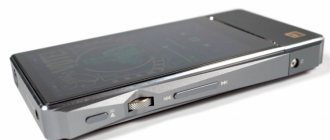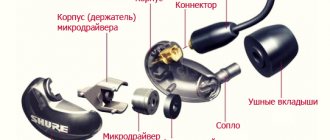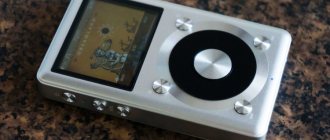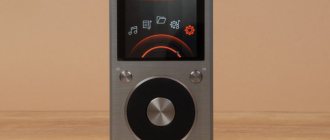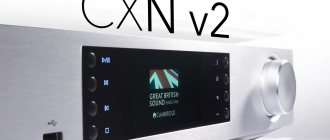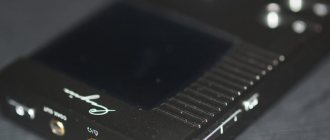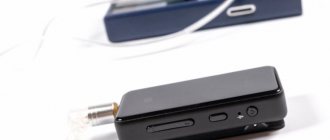We watch HD movies on HD TVs, play HD computer games on HD monitors, and in general, everything is in HD these days. The audio should also be in high resolution, right? What is needed for this? A good player that is capable of conveying all the details of a musical composition. Usually such portable Hi-End, Hi-Fi, Hi-Res devices cost a lot of money. But FiiO with its X3 proved that you can enjoy high-quality audio at a low cost, by the standards of such sound. The new second-generation FiiO X3 turned out to be even more successful than the first generation - turn on the music and welcome to the world of high-quality audio.
FiiO X3-II Titanium MP3 players on
Notify when on sale
Design, materials, assembly
FiiO X3-II is made in the same style as the models from the new line, namely X1 and X5-II. Externally, these are almost identical devices, which are assembled from aluminum and feel like an expensive and high-quality product. At the bottom there is a main control element in the shape of a circle.
The parts fit together in such a way that it gives the impression that the body is monolithic, but in fact it consists of parts. The button markings and branding on the back side are made with white paint, which is likely to peel off after several months of use. The silicone case in which the player is supplied seems to protect the player, but immediately makes it faceless. And we all know what happens to the device if sand or dust gets into the case - it just starts to scratch. So it definitely looks more fun without a case. And for those who don’t like the metallic look, there are three types of bright stickers: imitation carbon, wood and with the US flag.
Packaging and delivery
The box that I reviewed is not final yet, even the printing on it says about Fiio X3K, which will obviously be changed, but the name is not the point. The box is standard for Fiio, with a red and black print and a black cardboard box inside. There is a sticker on the box; by scraping off the protective layer, you can find out the authentication code. Enter it on the Fiio website and you will find out if your device is original. It is unlikely that anyone will undertake to fake the X3, but there were precedents with simpler models.
The box contains everything you need for work, in addition to the player itself you will receive: several protective films for the screen (one is already glued on from the factory), a silicone case, a MicroUSB cable, a cable for coaxial output, three sets of stickers for customizing the player and various instructions with warranty coupons. In general, everything you could want is included in the kit.
Ergonomics
The player weighs 135 g and such a brick feels weighty in your hand. Many will not be pleased with the dimensions, especially the thickness of 16 mm, but this is the price to pay for high-level audio circuitry.
Our competitors have exactly the same situation; it is impossible to find a similar class player with the thickness of a modern smartphone. Wearing the FiiO X3-II in jeans is not difficult, although at first it is a little unusual due to the baby’s “knocked-down” appearance.
Conclusions FiiO X3
Good sound and high ergonomics at an affordable price - this is how we can generally characterize the new product from FiiO.
This player now has practically no competitors in its price range (its main rival iBasso DX50 is coming out soon) and looks like a rather interesting proposal for use with low-impedance headphone models. Despite a number of shortcomings, it will allow many people to explore the world of high-quality portable sound. Author: Other authors:
Roman Kuznetsov (romanrex) 08/29/2013
Found a typo in the text?
Select and press
Ctrl+Enter
. This does not require registration. Thank you.
Control, connection
All controls in the player are mechanical, like an echo of the past, but in the Hi-Fi environment this is considered a standard; only a few such devices can boast of a touch screen. There are five buttons on the front that are responsible for switching tracks, returning, calling the context menu and confirming actions. The mechanical ring itself allows you to scroll through the menu and tracklist, similar to what we saw earlier in the iPod. Many did not like this type of control in the previous FiiO X1 and X5, but in reality this approach is still more convenient than just push-button control, and it also adds a touch of originality.
The display has a resolution of 320×240 pixels with a diagonal of 2”, everything is perfectly visible indoors, it fades almost completely in the sun, a typical mobile phone screen of the year 2006.
The menu has changed compared to the previous generation; it is extremely simple and intuitive. The main screen greets us with five icons - what is currently playing (launching what was last played), categories (distribution by genres, artists, albums, etc.), file browsing (allows you to manually find tracks on a memory card or connected drive ), playback settings and system settings. In the playback settings, you can select the playback mode, maximum volume level, amplifier mode, equalizer, shift the balance and change other parameters. System settings allow you to adjust parameters such as display brightness, turn-off time, sleep timer, USB mode (drive or DAC), select a theme, call up help, etc. It takes absolutely no time to get used to the controls, literally in a minute almost anyone , who is familiar with modern gadgets, is able to master the player.
On the left side you can find three buttons - power on and volume up/down, and there is also a reset hole. On the right there is only an open slot for MicroSD memory cards up to 128 GB. On the bottom edge there is a micro USB port for charging, connecting to a computer and using OTG, and on top there is a 3.5 mm headphone jack and a 3.5 mm linear output, which is combined with a digital coaxial one. The “back” of the device is completely empty of control elements. The only indicator is located on the front part at the very bottom and can glow in three colors: red (charging), blue (during operation) and green (fully charged).
Equipment FiiO X3
The player comes in a gift box.
The package includes: a white silicone case (a necessary addition), two screen protectors, an adapter for coaxial connection, a micro USB cable, a warranty booklet and an instruction manual.
The player doesn't look very nice in a white case, and for aesthetes a separate black case is available to order. The white case is a kind of demo version.
Sound
The audio architecture was built on SoC Ignetic JZ4760B and FPGA SA2000. Before the sound reaches the headphones, the signal passes through a Cirrus Logic CS4398-CZZ digital-to-analog converter and Texas Instruments OPA1642 and LMH6643 operational amplifiers. All these obscure names provide support for 192 kHz / 24-bit audio and, most importantly and significantly, support for DSD64/218 out of the box. Naturally, if we are talking about Direct Stream Digital, then lossless formats are also supported in the highest quality.
Okay, enough of this abstruseness, let's talk about the most important thing - the sound. Many people will not understand such a device, because it costs a lot of money, for which you can buy an average smartphone and listen to AK-47 and Noggano. But the person who listens to the FiiO X3-II paired with good headphones will have to admit that the sound is great. Almost everyone I gave the player to listen to during the test said that they had never heard their favorite music in such detail. In fact, this is true. The “native” sound of the player, without turning on the equalizer, splashes with details and balance, and what kind of balance - the serious circuit design of the ASUS EONE MKII MUSES DAC is very close in sound to the FiiO, but the latter has a warmer sound, does not have that scrupulous dryness that the brainchild of ASUS has.
The sound was assessed using four pairs of headphones - in-ear JVC HA-FRD80 and full-size Creative Aurvana Live, Koss BT540i, as well as the legendary beyerdynamic DT 770 PRO with an impedance of 250 Ohms. The music selection was taken from Prime Test CD #1 and personal collection, in particular, I listened to Michael Jackson's Thriller album in DSD format and ISO SACD image. The player works well with low-impedance “Jivicas” with maximum volume reserve, the sound is clear and truthful, all the pros and cons of the headphones were declassified immediately - the clicking noise has not gone away, that’s how it should be. Creative Aurvana Live, which, as I always believed, can be handled by almost any modern smartphone, showed me that it is too early to write them off - pleasant and deep bass appears, instruments on stage stand out and become clearly distinguishable, sibilance does not go away. Koss BT540i, as we already wrote in the review, is distinguished by its depth and relief of instruments, as well as crazy bass that penetrates into the very depths of the head.
And now the most interesting thing is how the FiiO X3 2nd gen coped with the beyerdynamic DT 770 PRO professional studio monitors. To begin with, I decided to listen to these headphones on my LG Optimus G. I laughed. Then I went and bought an LG G4 from a colleague - a little better, but far from the sound that such serious ears can give. And finally I get to the all-metal beauty, and then you realize that for your $200 there is simply no better player. The 250-Ohm headphones turn so easily, as if they were included earplugs for a smartphone - there is plenty of volume to spare, and if you turn the amplifier to High mode, you can wake up your neighbors. Well, the “baers” themselves are so good that they can’t help but make you fall in love with them from the first seconds, the sound is simply sexy, naturally sexy, and not with silicone and Botox, which is often found now.
Sound
The following headphones were used to listen to the player:
- HiFiMan Re600
- HiFiMan HE560
- Philips Fidelio X1
- Dunu DN-2000 and Titan 1
- Lear LUF-4F
- Rhapsodio RTi1
- Ambient Acoustics AM10
In the X3-2, Fiio tried to retain the sound that they found in the X1, but improved it in those areas where it was necessary. To say that the result is a player with the best sound would be a clear exaggeration, but in its price category the new X3 is perhaps ahead of all its competitors. In general, the newcomer’s pitch can be described as dynamic, with good energy and drive.
If one could slightly (I emphasize, slightly) find fault with the X1 for the lack of impact in the low frequencies, then in the X3-2 this is more than corrected. The bass is not only well controlled, but also delivered with pleasant energy and density. By simply selecting headphones to suit your taste, you can achieve almost any bass response, from a roaring wave of sound to an intelligent, elastic background for a melody. From the intelligent electronic music of Daft Punk to the unbridled neo-hard rockers of Royal Republic, the X3-II is at its best.
Mid frequencies are developed at a level worthy of the price category. Of course, top players outperform the newcomer in these parameters, but there is already a completely different category with a different price level. The mid frequencies are quite lively and emotional, the separation of instruments is at a decent level. The elaboration of background sounds is very decent, thanks to this, the depth of the imaginary scene is well constructed, and the width also does not leave much to be desired. The “holographic” effect characteristic of, for example, the QLS360 is not here, but the volume is conveyed, and the three-dimensional effects are also fascinating.
High frequencies are worked out and supplied in normal quantities. This may upset owners of bright headphones and people sensitive to high frequencies, but here, in fact, “what is is what is”, so if there are a lot of high frequencies on the recording, the player will play them. High end detail is very good, percussion, cymbals, and high notes are easy to discern, as are decays. Tracks that have inherent volume benefit greatly from this; sometimes you can even guess the parameters of the room in which a particular track was recorded.
A little about subjective comparison with other players, for starters from Fiio. The X1 lags behind in sound, especially in the low-frequency range, although with a good selection of headphones it is not so easy to hear the difference. The X5 still retains its leadership in sound, it is even more dynamic, it plays out macrodynamics even better, although its high-frequency delivery may seem even sharper to many than the X3-2. Now as for the competitors. The iBasso DX50 is left behind due to its dull and lifeless presentation. The iHiFi 770 loses in detail, but gains a little in musicality, but due to the confusing controls, it can only be recommended to very patient users. Aune M1 wins in sound, but loses in other performance qualities, and therefore stands a little apart. HiFiMan 603 has a specific sound, and therefore I will not directly compare it with other sources, since a lot depends on the headphones and personal tastes.
Results
FiiO X3-II turned out to be a decent portable Hi-Res player without serious technical shortcomings. The device, as it should, immerses the listener in the world of music and reveals new details in the compositions. If you have already acquired good headphones and you are not satisfied with their sound with your smartphone, then be sure to pay attention to the second generation FiiO X3.
Liked: + Sound + Power + Ability to work in sound card / DAC mode + Appearance + Quality of materials, assembly + Excellent packaging + Simple controls + DSD support
Didn't like it: - No
| FiiO X3-II Titanium Notify when available | |
| Type | Portable Hi-Res player |
| Built-in memory / HDD capacity | — |
| Memory card slot | micro SD (up to 128 GB) |
| Audio | DSD, APE, FLAC, ALAC, WAV, AIFF, WMA, AAC, OGG, MP3, MP2 |
| Display | color, 2″, 320×240 pixels |
| Video camera (video shooting) | — |
| FM tuner | — |
| Recording from FM radio | — |
| Equalizer | + |
| Wi-Fi support | — |
| Bluetooth support | — |
| Dictaphone | — |
| Line input | — |
| Video output | — |
| Other functions | works as a USB DAC with support for 24/192 and DSD formats |
| Nutrition | 2600 mAh battery, more than 11 hours of music playback |
| Charger | USB |
| Interface | USB |
| Waterproof housing | — |
| Dimensions, mm | 96,7×57,7×16,1 |
| Weight, g | 135 |
Specifications
Amplifier
- Output Power: 224 mW @ 16Ω, 200 mW @ 32Ω, 24 mW @ 300Ω
- Output level: >2.5V
- Recommended load impedance: 16Ω - 150Ω
- Total Harmonic Distortion + Noise: <0.0015% (headphone output into 32Ω load)
- Signal to noise ratio: >113 dB
- Frequency range: 20 Hz – 20 KHz (±0.1 dB)
- Output impedance: <0.2Ω
- Maximum output voltage (peak-to-peak): >7.5 V
- Maximum output current: >84 mA
DAC
- Output level: 1.45V
- Total harmonic distortion + noise: <0,0009%
- Signal to noise ratio: >113 dB
- Frequency range: 20 Hz – 20 KHz (±0.1 dB)
Player
- SoC: JZ4760B
- DAC: CS4398
- Amplifier: OPA1642+LMH6643
- LPF: OPA1642
- DSD format support: DSD64,DSD128, DSF, DFF, SACD ISO
- Support for lossless formats: APE Fast: 192/24, APE Normal and higher: 96/24, FLAC:192/24, WAV:192/24, WMA Lossless:96/24, ALAC: 192/24
- Support for lossy formats: MP2, MP3, AAC, WMA, OGG
- USB DAC mode: asynchronous, up to 192/24
- Battery: 2600 mAh
- Operating time on one charge: >11 h
- Charging time: <3h (charger 5V, 2A)
- Dimensions: 96.7 mm × 57.7 mm × 16.1 mm
- Weight: 135 g


